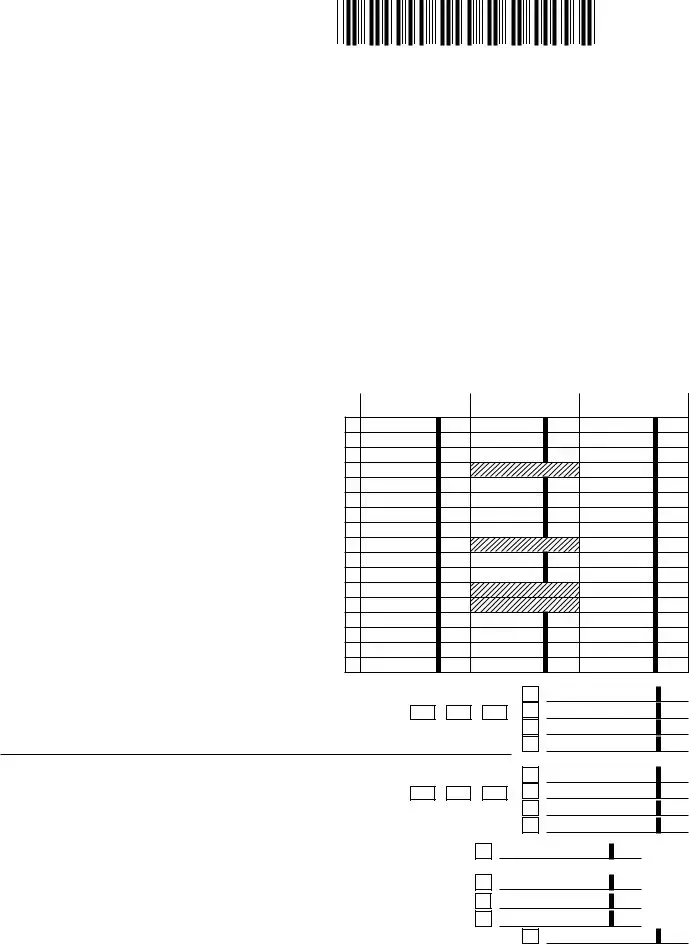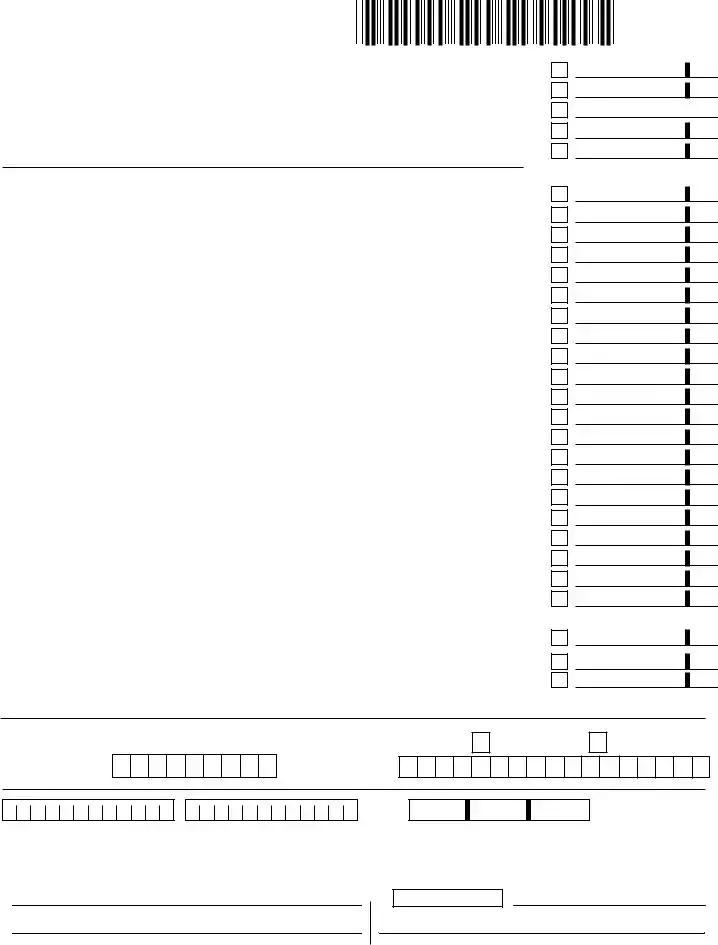33. |
Earned income credit from worksheet in Instruction 20 |
. |
. . . |
. . . . . |
. . . |
. . |
. . . . . |
. . . . . . . . . . . . . . . . . . . . . . . . . . |
|
. . |
|
|
34. |
Poverty level credit from worksheet in Instruction 20 |
|
|
|
|
|
|
|
|
|
|
|
|
|
▶ |
|
. |
. . . |
. . . . . |
. . . |
. . |
. . . . . |
. . . . . . . . . . . . . . . . . . . . . . . . . . |
|
. . |
|
|
35. |
Other income tax credits for individuals from Part G, line 8 of Form 502CR. (Attach Form 502CR) |
|
|
|
|
|
|
36. |
Business tax credits (Attach Form 500CR) |
|
|
|
|
|
|
|
|
|
|
|
|
|
▶ |
|
. |
. . . |
. . . . . |
. . . |
. . |
. . . . . |
. . . . . . . . . . . . . . . . . . . . . . . . . . |
|
. . |
|
|
37. |
Total credits (Add lines 33 through 36) |
. |
. . . |
. . . . . |
. . . |
. . |
. . . . . |
. . . . . . . . . . . . . . . . . . . . . . . . . . |
|
. . |
|
|
38. |
Maryland tax after credits (Subtract line 37 from line 32c) If less than 0, enter 0. . . . |
. . . |
. . |
. . . . . |
. . . . . . . . . . . . . . . . . . . . . . . . . . |
|
. . |
|
|
|
|
|
|
|
|
|
|
|
|
|
|
|
|
|
|
|
|
▶ |
|
39. |
Contribution to Chesapeake Bay and Endangered Species Fund (See Instruction 21) |
|
|
|
|
|
|
|
|
|
. . . |
. . |
. . . . . |
. . . . . . . . . . . . . . . . . . . . . . . . . . |
|
. . |
|
|
40. |
Contribution to Fair Campaign Financing Fund (See Instruction 21) |
|
|
|
|
|
|
|
|
|
|
|
|
▶ |
|
. |
. . . |
. . . . . |
. . . |
. . |
. . . . . |
. . . . . . . . . . . . . . . . . . . . . . . . . . |
|
. . |
|
|
41. |
Contribution to Maryland Cancer Fund (See Instruction 21) |
|
|
|
|
|
|
|
|
|
|
|
|
▶ |
|
. |
. . . |
. . . . . |
. . . |
. . |
. . . . . |
. . . . . . . . . . . . . . . . . . . . . . . . . . |
|
. . |
|
|
42. |
Total Maryland income tax and contributions (Add lines 38 through 41) |
|
. . . |
. . . . . |
. . . |
. . |
. . . . . |
. . . . . . . . . . . . . . . . . . . . . . . . . . |
|
. . |
|
|
|
|
|
|
|
|
|
|
|
|
|
|
|
|
|
|
|
|
▶ |
|
43. |
Total Maryland tax withheld (Enter total from and attach your W-2 and 1099 forms if MD tax is withheld) |
|
|
|
|
. . |
|
|
44. |
2005 estimated tax payments, amount applied from 2004 return and payment made with an extension request Form 502E |
|
|
|
|
▶ |
|
|
. . |
|
|
45. |
Refundable earned income credit from worksheet in Instruction 20 |
|
|
|
|
|
|
|
|
|
|
|
|
▶ |
|
. |
. . . |
. . . . . |
. . . |
. . |
. . . . . |
. . . . . . . . . . . . . . . . . . . . . . . . . . |
|
. . |
|
|
46. |
Nonresident tax paid by pass-through entities (Attach Schedule K-1 or other statement) |
|
|
|
▶ |
|
|
|
47. |
Refundable income tax credits from Part H, line 5 of Form 502CR (Attach Form 502CR. See Instruction 22) |
|
. . |
|
|
48. |
Total payments and credits (Add lines 43 through 47) |
. |
. . . |
. . . . . |
. . . |
. . |
. . . . . |
. . . . . . . . . . . . . . . . . . . . . . . . . . |
|
. . |
|
|
|
|
|
|
|
|
|
|
|
|
|
|
|
|
|
|
|
|
|
|
|
|
|
|
|
|
|
|
|
|
|
|
|
|
|
|
|
|
▶ |
|
49. |
Balance due (If line 42 is more than line 48, subtract line 48 from line 42) |
|
|
|
|
|
|
|
|
|
|
|
|
|
. |
. . . |
. . . . . |
. . . |
. . |
. . . . . |
. . . . . . . . . . . . . . . . . . . . . . . . . . |
|
. . |
|
|
50. |
Overpayment (If line 42 is less than line 48, subtract line 42 from line 48) |
|
|
|
|
|
|
|
|
|
|
|
|
▶ |
|
. |
. . . |
. . . . . |
. . . |
. . |
. . . . . |
. . . . . . . . . . . . . . . . . . . . . . . . . . |
|
. . |
|
|
51. |
Amount of overpayment TO BE APPLIED TO 2006 ESTIMATED TAX |
|
|
|
▶ |
51 |
|
|
|
|
|
|
|
|
|
. |
. . . . |
. |
|
|
|
|
|
|
|
|
|
|
|
|
|
|
|
|
|
|
|
|
|
|
|
|
|
|
|
|
|
|
52. |
Amount of overpayment TO BE REFUNDED TO YOU (Subtract line 51 from line 50) |
REFUND ▶ |
|
|
|
|
|
|
|
53. |
Interest charges from Form 502UP |
|
|
or for late filing |
|
|
|
|
|
|
|
(See Instruction 23) Total |
|
|
▶ |
|
|
|
|
|
|
|
|
|
|
|
|
|
54. |
TOTAL AMOUNT DUE (Add line 49 and line 53) |
IF $1 OR MORE, PAY IN FULL WITH THIS RETURN. |
|
|
|
|
|
|
|
|
|
|
|
|
|
|
|
|
|
For credit card payment check here |
|
|
and see Instruction 25. Direct debit is available only if you file electronically. |
|
|
|
|
|
|

